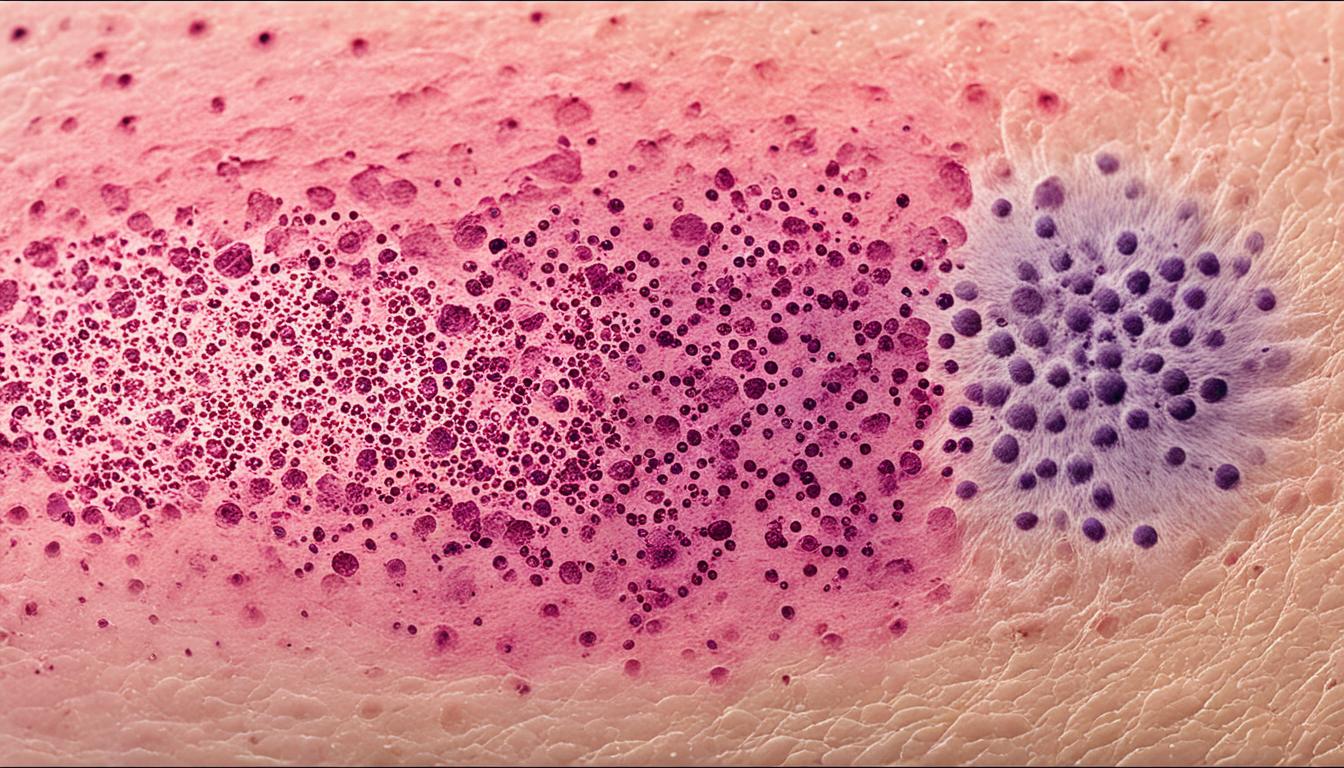A nevus, or mole, is a common skin lesion made of melanocytes. These lesions vary in type, including congenital nevi and atypical nevi. Some types, like congenital nevi, can be present at birth and may turn into skin cancer.
Congenital melanocytic nevi are lesions with melanocytes in the skin’s deeper layers. They may show signs of spreading. Larger nevi can be riskier, needing close monitoring for cancer.
Doctors diagnose congenital melanocytic nevi using skin exams and skin samples. There isn’t a one-size-fits-all treatment. But, some cases may need the nevi surgically removed.
Specialist care might be necessary for patients with very large congenital nevi. This care can include seeing a pediatric neurologist and sometimes treatments like surgery or chemotherapy.
Key Takeaways:
- Nevus, or mole, is a common pigmented skin lesion composed of melanocytes.
- Congenital melanocytic nevi are pigmented lesions present at birth with a potential risk of transformation into malignant melanoma.
- The incidence of congenital melanocytic nevi varies and is associated with somatic mutations in genes involved in the mitogen-activated protein kinase pathway.
- Diagnosis of congenital melanocytic nevi can be made through dermoscopy and biopsy, with treatment options including excision surgery.
- Giant congenital melanocytic nevi may require evaluation by a pediatric neurologist and additional treatments.
Risk Factors and Complications of Giant Congenital Melanocytic Nevus
Giant congenital melanocytic nevi (GCMN) are rare and large birthmarks. They are different shades of brown or black. These marks can have a big impact on people’s lives. They might cause stress because of how they look. There’s also a higher chance for people with GCMN to get a serious type of skin cancer called melanoma.
Though the risk of melanoma in GCMN is low, it still needs attention. About 0 to 3.8% of these cases turn into cancer. That’s why it’s important to keep an eye on these birthmarks. Doctors need to watch them closely and treat any changes early on. Sometimes, GCMN can also lead to another problem called neurocutaneous melanosis (NCM).
NCM affects the brain and spinal cord, causing issues like seizures and pressure in the head. This means people with GCMN should get regular check-ups. Doctors need to look not only for melanoma risks but also possible brain and nerve problems.
Besides melanoma and NCM, GCMN can cause other growths. These include tumors in soft tissues, fatty tumors, and nerve cell tumors. The exact reason behind GCMN is not clear. But, we know it has something to do with gene changes.
Most times, GCMN doesn’t run in families but happens because of gene changes after birth. Early diagnosis and care are key to managing GCMN. This helps lower the chance of problems linked to this birthmark.
Risk Factors and Complications of Giant Congenital Melanocytic Nevus
| Risk Factors | Complications |
|---|---|
| Abnormally large pigmented nevi present from birth | Malignant melanoma |
| Neurocutaneous melanosis (NCM) | |
| Soft tissue tumors | |
| Fatty tumors | |
| Tumors of the nerve cells | |
| Genetic mutations (NRAS, BRAF) |
Innovative Stem Cell Therapy for Nevus Treatment
Stem cell therapy is a new way to treat nevi, including congenital melanocytic nevi. These cells, known for their healing powers, could replace or fix the abnormal pigmented cells in nevi. Studies so far show that using stem cell therapy to treat nevi has some real promise.
How does stem cell therapy work for nevi? First, doctors take and grow stem cells. Then, they place them where they’re needed. There are different kinds of stem cells used, like mesenchymal and adipose-derived stem cells. This treatment seems to be both safe and effective, with few risks or side effects.
Research is still ongoing to make using stem cells even better for nevi. The aim is to improve how well patients do. Stem cell therapy is part of a bigger field called regenerative medicine. It uses the body’s own healing to treat diseases. This gives people with nevi a new hope and way to treat their condition.

